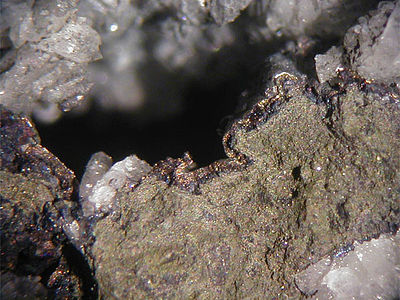Nukundamit
| Nukundamit | |
|---|---|
| Light bronze-colored nukundamite on fine-grain pyrite from Ronneburg (Thuringia) , Germany (image width 7 mm) | |
| General and classification | |
| other names |
IMA1978-037 |
| chemical formula | Cu 3.4 Fe 0.6 S 4 |
|
Mineral class (and possibly department) |
Sulphides and sulphosalts - metal sulphides, M: S = 1: 1 |
|
System no. to Strunz and to Dana |
2.CA.10 ( 8th edition : II / C.22.40) 02.09.15.01 |
| Crystallographic Data | |
| Crystal system | trigonal |
| Crystal class ; symbol | ditrigonal-scalenohedral; 3 2 / m |
| Room group (no.) | P 3 m 1 (No. 164) |
| Lattice parameters | a = 3.78 Å ; c = 11.19 Å |
| Formula units | Z = 1 |
| Physical Properties | |
| Mohs hardness | Please complete |
| Density (g / cm 3 ) | 4.30 |
| Cleavage | Please complete |
| colour | copper colored |
| Line color | Please complete |
| transparency | opaque |
| shine | metallic |
| Crystal optics | |
| Pleochroism | red-orange to gray |
Nukundamit is a rare mineral from the mineral class of sulfides and sulfosalts . It crystallizes in the trigonal crystal system with the chemical composition Cu 3.4 Fe 0.6 S 4 and forms tabular copper-colored crystals up to 2 mm in size or larger irregularly shaped masses.
Etymology and history
Nukundamit was first found in 1979 by CM Rice, D. Atkin, JFW Bowles and AJ Criddle in the Undu mine near Nukundamu on the Fiji island of Vanua Levu . They named it after the type locality . It was assumed that it could be identical to Idait Cu 4 FeS 6 . However, this was refuted by Asahiko Sugaki, Hiromi Shima, Arashi Kitakaze and Tadato Mizota, who succeeded in artificially producing Nukundamit by hydrothermal synthesis and measuring the exact properties.
classification
Nukundamit is in the system after Strunz counted as sulfides and sulfosalts. In the 8th edition, it belongs to a subgroup of sulfides and sulfosalts with a ratio of metal to sulfur of 1: 1, together with covellin , idaite and klockmannite .
In the 9th edition of the system , it forms a separate group within the subdivision of sulfides and sulfosalts with a ratio of metal to sulfur of 1: 1 and copper .
According to the Dana system , Nukundamit also forms its own group within the subdivision of sulfides - including selenides and tellurides - with the composition A m B n X p and the ratio of (m + n) to p of 1: 1.
Education and Locations
Nukundamit forms secondary mineral from pyrite and chalcopyrite . In addition to these, covelline, bornite and sphalerite can occur as additional accompanying minerals .
In addition to the type locality, Nukundamite was found in Mount Gunson , Australia , on the Murwinkel and in the Schwarzleograben in Salzburg ( Austria ), in the uranium mining area of Ronneburg in Germany , the Grasberg mine in Papua New Guinea , Okayama in Japan , Drammen and Grorud in Norway, Maramureș in Found in Romania, the US states of Arizona and Utah and on the mid-Atlantic ridge .
Crystal structure
Nukundamit crystallizes trigonal in the space group P 3 m 1 with the lattice parameters a = 3.78 Å and c = 11.19 Å as well as one formula unit per unit cell .
See also
literature
- Nukundamit . In: John W. Anthony et al .: Handbook of Mineralogy, Vol. 1: Elements, sulfides, sulfosalts . Mineral Data Publ., Tucson, Ariz. 1990, p. 101. ISBN 0-9622097-0-8 .
Web links
- Mineral Atlas: Nukundamit (wiki)
- mindat.org - Nukundamite (Eng.)
Individual evidence
- ^ IMA / CNMNC List of Mineral Names; Feb. 2013 (PDF 1.3 MB)
- ↑ a b c d Asahiko Sugaki, Hiromi Shima, Arashi Kitakaze and Tadato Mizota: Hydrothermal synthesis of nukundamite and its crystal structure. In: American Mineralogist. 1981, 66, pp. 398-402 ( full text, pdf ).
- ↑ CM Rice, D. Atkin, JFW Bowles, AJ Criddle: Nukundamite, a New Mineral, and Idaite . In: Mineralogical Magazine . tape 43 , no. 326 , 1979, pp. 193-200 , doi : 10.1180 / minmag.1979.043.326.01 .
- ^ New Dana Classification of Sulfide Minerals
- ↑ mindat.org - Nukundamite
